Related sites:
Newsletter: Perspectives on Power Platform
Company: Niiranen Advisory Oy
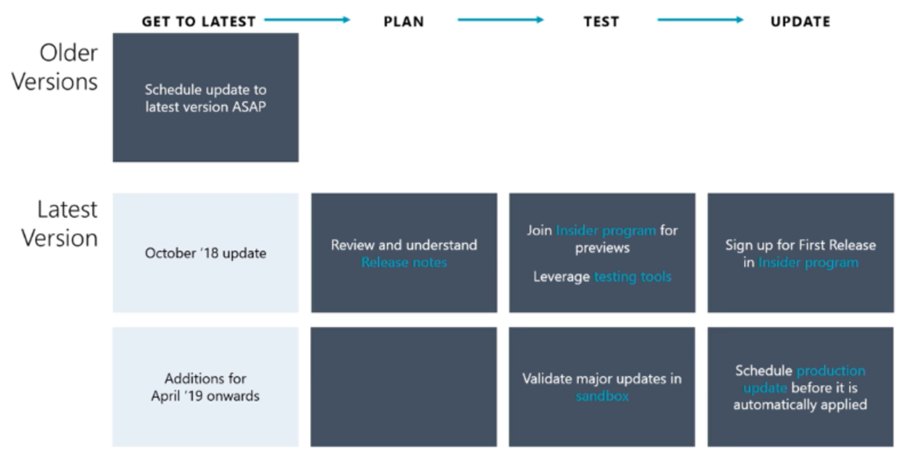
Have you been administering organizations running on the online version of Dynamics CRM / Dynamics 365 Customer Engagement for a while now? If so, you will be familiar with this screen:
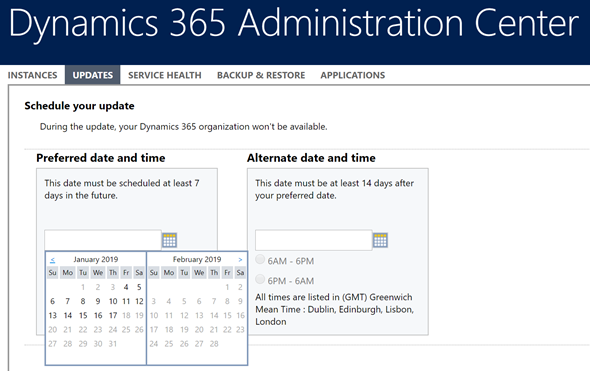
That is essentially CDU in flesh. CDU of course stands for Customer Driven Update, the process through which Microsoft has allowed online customers to decide when their instances are updated to the latest available version of Dynamics 365 CE. While it hasn’t been a completely open schedule of “pick whichever date you want”, the availability of update slots for a period of up to six months has formed the backbone of how many organizations plan the dates on their business application development roadmaps.
This is all about to change very soon, as CDU will be going away. The plan was laid out on a post in the beginning of July already, but I suspect not everyone has yet quite grasped the practical impact of what “Modernizing the way we update Dynamics 365” truly means. Admins of online tenants with v8.2 orgs will have been receiving the following notifications into their mailbox recently:
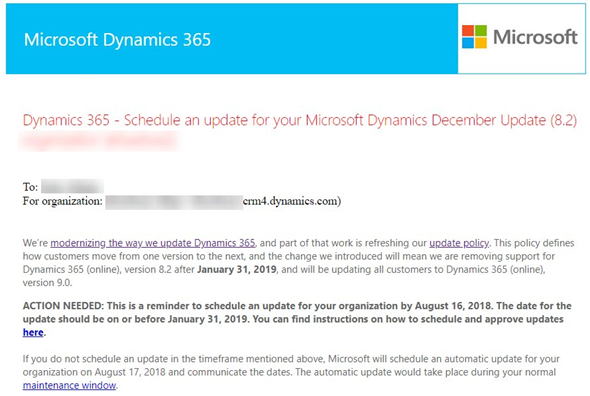
Those who have reacted to this request to schedule their V9 updates will have seen a fairly familiar calendar with update time slots all the way up until January 2019. The thing you should keep in mind is that this is the last time you will ever see that CDU calendar. You cannot freely schedule your Dynamics 365 CE online updates ever again, once you’re on V9+. Enjoy your final Customer Driven Update, folks!
“What’s going on here?!? Is Microsoft giving up on maintaining their Dynamics 365 CE cloud? Will we no longer get updates for this product?”
It’s exactly the opposite, in fact. Microsoft is so determined to get all of their online customers to run the latest & greatest bits that they’re transforming their update delivery model into continuous deployment. From February 2019 onward, everyone will (in theory) be running the exact same version and no org will be left behind – or be allowed to. Then shortly after, it’s time for the next major release, V10, coming in April 2019:
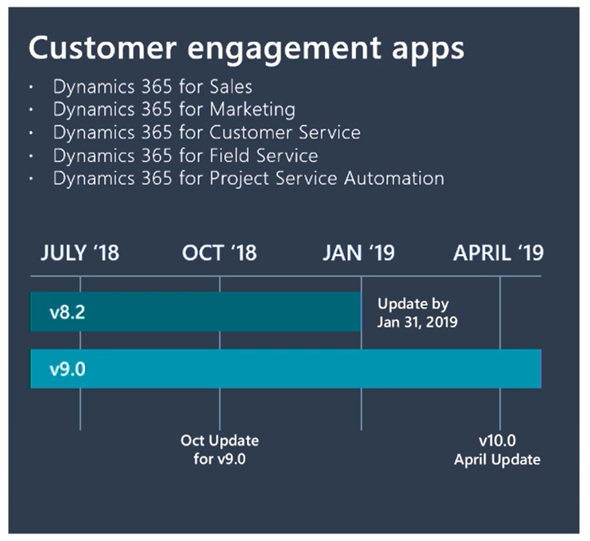
Alright, so there is no way of opting out from major releases and waiting for the dust to settle for a while before rolling it into your own instances. This just means you better be ready for the changes as they take place, so preparation and thorough understanding of the releases notes for the coming versions is going to be crucial. And how will we be able to test the new version in advance, you might ask. The answer is you can’t do that just yet, but before V10 rolls out there will be a new mechanism in place for a First Release instance:
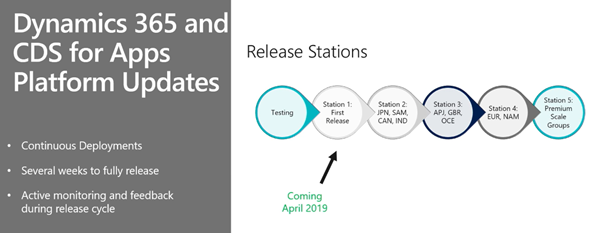
As we can see from the Release Stations diagram above, the updates will be rolled out to different “rings” over a period of several weeks. Not even Microsoft wants to deploy the updates to every single environment at the click of one button, so they start from the smaller geos like Japan and Canada, gather telemetry on the update process and then gradually move to the largest geos of North America and Europe.
Telemetry will also play a key role in how Microsoft plans to deal with the inevitable need to deprecate and remove older functionality from the platform. Although the new Dynamics 365 update policy aims to preserve backward compatibility and present new features as “off by default”, there are going to be scenarios where it’s not just a matter of adding more and more stuff onto the ever expanding cloud platform. Since MS hosts all of the online instances, they can also measure how much each product feature or platform component is utilized by the customers. Decisions on how to deal with deprecation will therefore be much more data driven than it could have been in the past.
Just because the product is moving into an ever more “cloud native” delivery model doesn’t mean that there’s no need to test your customizations, extensions and integrations. While the process aims to reduce the chances of breaking changes interfering with the day-to-day use of Dynamics 365, there will of course be some changes that break stuff in reality. While the First Release environment will only give you a few weeks notice for performing your own changes in preparation of the version update, the Insider programs for Dynamics 365 will be your best hope to have earlier access to the information on what’s coming & how it may impact you.

To fully grasp the how, why and when of this new update policy for Dynamics 365, I highly recommend you to watch the session from Business Applications Summit 2018 on Dynamics 365 and Update Cadence. I’m hoping that Microsoft will make this information available in more convenient formats than live recordings in the future, so that this bold “one version for all” vision can be better understood by partners and customers. After all, we’re only in the process of digesting the October ’18 releases notes highlights, but in reality the V10 update isn’t that far away in the horizon anymore.
For all of us who are used to thinking about Dynamics 365 version updates as projects, it’s time to start shifting our thought process to the continuous delivery mode. Many of the “born in the cloud” products like Dynamics 365 Business Central or PowerApps are already now operating according to this one version principle, so it makes perfect sense to try and align the Common Data Service for Apps platform and the Dynamics 365 Customer Engagement applications with this new reality. Not just from a technical standpoint, but also the adoption of new product features that can be enabled when needed is going to be quite different from the traditional way of features arriving at the very moment a version update is deployed.
Interesting and informative post. As a consulting firm in one of the smaller geo rings Canada let’s just say that this wasn’t clear to us or a couple of our key clients and plunging ahead into an upgrade that wasn’t 100% fully tested caused 2 plus months of headaches when one of the clients wondered whether we really knew what we were doing, rather than bugs in the new code.
It will be interesting to see how this works. Version 9 saw Microsoft adds lots of major bugs into the process, many of them stopping deployment, stopping auditing and other fundamental problems.
If Microsoft wants Dynamics to be used on Enterprise scale projects it needs to resolve the poor quality of their new releases.
it would be better to have one stable release rather than 2 rushed buggy releases.
Giving customer weeks to test all of their customisations isn’t long. The fact Microsoft can’t test them in the months it has shows this
We’ve been experiencing the frustration of this.
A release is dropped to one of the lower environments (where we’re working on enhancements). Something breaks. Time to go into ‘was it us or them’ mode to figure out where the bug came from. Can the issue be recreated in prod? Was it due to a future enhancement we’re working on? If it’s an issue with the Portal, is the root cause from CRM, or did something portal specific break (like the time when they changed the html tag IDs, adding a guid to the middle).
A few hours later, we can’t find any evidence it’s us, submit a ticket to support.
Then the rest of the day is to find a work around to the issue because the issue may or may not be deemed worthy of fixing (in a reasonable amount of time), and there is not stopping the release.
Too much time wasted.
[…] The End Is Near for Dynamics 365 (Customer Driven) Updates […]
Great blog, Jukka.
[…] tekniska hållet. En av de artiklar som jag tyckte var intressant under den senaste månaden var ”The End is near for dynamics 365 customer driven updates” som handlar om förändringarna kring när uppdateringar kan ske för online versionen av […]
[…] The End Is Near for Dynamics 365 (Customer Driven) Updates […]
The new Microsoft Dynamics 365 release schedule is coming
You might have missed or ignored Microsoft’s post on the new update cadence because few people use the